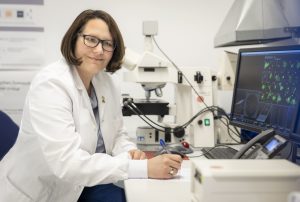Sabine Taschner-Mandl is elected to the executive board of Europe’s neuroblastoma network SIOPEN
Developing new therapies for childhood nerve tumors and identifying more molecular markers for better diagnosis – this is what Sabine Taschner-Mandl strives for in her new role as Executive Committee Board Member of the European Neuroblastoma Research Group SIOPEN.

Sabine Taschner-Mandl, PhD, head of the Tumor Biology Research Group at St. Anna Children’s Cancer Research Institute, has recently been elected to the Executive Committee Board of the International Society of Pediatric Oncology Europe Neuroblastoma Group (SIOPEN). For the first time a molecular biologist joins the Board, which until now has been composed mainly of clinicians. Sabine Taschner-Mandl’s election was confirmed at this year’s SIOPEN Annual General Meeting in Barcelona at the beginning of October.
Discovering tumor targets
SIOPEN’s declared aim is to improve the survival of children with neuroblastoma – a tumor that arises from immature nerve cells. When asked how she plans to drive this goal forward, Sabine Taschner-Mandl explains, “I want to promote translational research and interdisciplinary teamwork within the study group. Two aspects are particularly important to me. First, we would like to introduce significantly more targeted therapies, not only in early phase I or II studies, but also in larger trials. To identify the most effective drugs, a detailed knowledge of the tumor biology is essential. This is why molecular tumor profiles need to be incorporated into translational studies.” Secondly, Sabine Taschner-Mandl emphasizes the prognostic role of biomarkers in predicting which patients will benefit from treatment, and indicating if treatment may need to be adapted.
“We need more molecular markers to tell us how efficient a therapy is. Such markers allow us to early identify those children, who do not respond or do not respond sufficiently to standard therapies. To improve treatment for the latter patient groups in the future, it is essential to implement translational research findings into clinical trial designs as quickly as possible in order to guide treatment decisions.”
Sabine Taschner-Mandl
Dream of borderless research
The Executive Committee Board meets once a month – at the moment virtually – to decide on clinical trials and projects and to promote networking. “In addition, we also aim at solving problems in currently running translational studies,” Sabine Taschner-Mandl points out. She refers, for instance, to difficulties in cross border research activities. To give an example, sometimes it is not possible to ship samples from one country to another, because national interpretations of European directives can differ substantially. “We hope to raise awareness to such problems with the aim to support joint SIOPEN projects with the necessary infrastructure, for example by creating a central database, namely the BIOPORTAL.”
Austria is one of the smaller countries with comparatively few study patients within SIOPEN. “As Country Representative, I am particularly excited to represent Austria and St. Anna Children’s Cancer Research Institute internationally,” Sabine Taschner-Mandl adds.
The International Society of Pediatric Oncology Europe Neuroblastoma Group (SIOPEN) Association has its registered office in Vienna and was founded during the presidency period of Univ.-Prof. Ruth Ladenstein, MD, MBA, cPM, for SIOPEN in Vienna in 2009. The SIOPEN Association fosters neuroblastoma research and enables long-term sustainability of the group. Currently, the SIOPEN Association has 432 active members in 34 countries and 29 countries are involved in SIOPEN studies. www.siopen.net
About Sabine Taschner-Mandl, PhD
Sabine Taschner-Mandl, PhD has been head of the Tumor Biology group at St. Anna Children’s Cancer Research since 2018, where she has been working as a scientist since 2008. In addition, she is a lecturer at the Medical University of Vienna and Vienna University of Technology. Sabine Taschner-Mandl completed her studies of biology at the University of Vienna with a diploma thesis in vaccine development at Intercell. This was followed by a dissertation and a postdoc position at the Institute of Immunology at the Medical University of Vienna. Besides her research work at St. Anna Children’s Cancer Research Institute, Sabine Taschner-Mandl was a visiting scientist at Significo and the University of Helsinki as part of the EC-FP7 Marie Curie Program.
For her research, Sabine Taschner-Mandl has received numerous grants, among others from the Austrian Research Promotion Agency (FFG), the Vienna Science, Research and Technology Fund (WWTF), and the European Commission’s ERA-NET initiative.
About neuroblastoma
Neuroblastoma accounts for ten percent of childhood cancer deaths. It has a very broad spectrum of different forms, ranging from harmless variants for which watchful waiting is justified to very aggressive forms that require immediate, comprehensive and intensive treatment.
High-risk neuroblastomas are tumors harboring a MYCN amplification, independent of age, or metastatic tumors in children aged twelve months or older. Unfortunately, the prognosis is still unsatisfactory, with only about half of the children with high-risk neuroblastoma surviving the disease in the long-term. Current standard treatment includes chemotherapy, surgery, autologous stem cell rescue, and isotretionin in combination with immunotherapy.